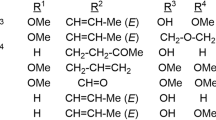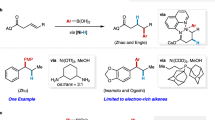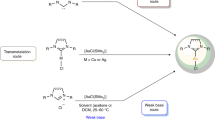Abstract
Catalytic reduction of carboxamides into their corresponding amines is an attractive but extremely challenging transformation, which often meets with limited success; the valuable amine products drive ongoing research in this area. Here we show the direct deoxygenation of carboxamides using earth-abundant lanthanum catalysts in the presence of HBpin, presenting good to excellent yields with broad substrate scope and functional group/heteroatom tolerance. Moreover, this method is also effective in catalysing the hydroboration of esters. Finally, selective cleavage of the amide group bonds (C–N versus C–O) could be achieved based on the nature of the nitrogen substituents.
This is a preview of subscription content, access via your institution
Access options
Access Nature and 54 other Nature Portfolio journals
Get Nature+, our best-value online-access subscription
$29.99 / 30 days
cancel any time
Subscribe to this journal
Receive 12 digital issues and online access to articles
$119.00 per year
only $9.92 per issue
Buy this article
- Purchase on Springer Link
- Instant access to full article PDF
Prices may be subject to local taxes which are calculated during checkout



Similar content being viewed by others
Data availability
The crystallography data for compounds 1, 2, 3, 4, 5 and 20 have been deposited at the Cambridge Crystallographic Data Centre (CCDC) as 1945093–1945098, respectively and can be obtained free of charge from the CCDC via www.ccdc.cam.ac.uk/getstructures. Experimental details, NMR spectra, details of kinetics experiments, and crystallographic information files are included as Supplementary Information. All other data are available from the authors on reasonable request.
References
Magano, J. & Dunetz, J. R. Large-scale carbonyl reductions in the pharmaceutical industry. Org. Process. Res. Dev. 16, 1156–1184 (2012).
Chong, C. C. & Kinjo, R. Catalytic hydroboration of carbonyl derivatives, imines, and carbon dioxide. ACS Catal. 5, 3238–3259 (2015).
Dagorne, S. & Wehmschulte, R. Recent developments on the use of group 13 metal complexes in catalysis. ChemCatChem 10, 2509–2520 (2018).
Mukherjee, A. & Milstein, D. Homogeneous catalysis by cobalt and manganese pincer complexes. ACS Catal. 8, 11435–11469 (2018).
Wei, D. & Darcel, C. Iron catalysis in reduction and hydrometalation reactions. Chem. Rev. 119, 2550–2610 (2019).
Geier, S. J., Vogels, C. M. & Westcott, S. A. in Boron Reagents in Synthesis Vol. 1236, ACS Symposium Series (ed. Coca, A.) Ch. 6, 209–225 (American Chemical Society, 2016).
Zaidlewicz, M., Wolan, A. & Budny, M. in Comprehensive Organic Synthesis II 2nd edn (ed Knochel, P.) 877–963 (Elsevier, 2014).
Fan, W., Li, L. & Zhang, G. Branched-selective alkene hydroboration catalyzed by earth-abundant metals. J. Org. Chem. 84, 5987–5996 (2019).
Shegavi, M. L. & Bose, S. K. Recent advances in the catalytic hydroboration of carbonyl compounds. Catal. Sci. Technol. 119, 2550–2610 (2019).
Stachowiak, H., Kaźmierczak, J., Kuciński, K. & Hreczycho, G. Catalyst-free and solvent-free hydroboration of aldehydes. Green. Chem. 20, 1738–1742 (2018).
Xu, X. et al. Catalyst-free approach for hydroboration of carboxylic acids under mild conditions. ACS Omega 4, 6775–6783 (2019).
Frick, M., Horn, J., Wadepohl, H., Kaifer, E. & Himmel, H.-J. Catalyst-free hydroboration of CO2 with a nucleophilic diborane(4). Chem. Eur. J. 24, 16983–16986 (2018).
Yuan, K. et al. Pyridyl directed catalyst-free trans-hydroboration of internal alkynes. Org. Lett. 18, 720–723 (2016).
Wang, W. et al. Catalyst-free and solvent-free hydroboration of ketones. N. J. Chem. 14, 3255–3258 (2019).
Zhu, Z. et al. Lanthanide aryloxides catalyzed hydroboration of aldehydes and ketones. Catal. Commun. 112, 26–30 (2018).
Patnaik, S. & Sadow, A. D. Interconverting lanthanum hydride and borohydride catalysts for C=O reduction and C–O bond cleavage. Angew. Chem. Int. Ed. 58, 2505–2509 (2019).
Yan, D. et al. Highly efficient hydroboration of carbonyl compounds catalyzed by tris(methylcyclopentadienyl)lanthanide complexes. Org. Biomol. Chem. 16, 2787–2791 (2018).
Chen, S. et al. Tris(cyclopentadienyl)lanthanide complexes as catalysts for hydroboration reaction toward aldehydes and ketones. Org. Lett. 19, 3382–3385 (2017).
Weidner, V. L., Barger, C. J., Delferro, M., Lohr, T. L. & Marks, T. J. Rapid, mild, and selective ketone and aldehyde hydroboration/reduction mediated by a simple lanthanide catalyst. ACS Catal. 7, 1244–1247 (2017).
Dudnik, A. S., Weidner, V. L., Motta, A., Delferro, M. & Marks, T. J. Atom-efficient regioselective 1,2-dearomatization of functionalized pyridines by an earth-abundant organolanthanide catalyst. Nat. Chem. 6, 1100 (2014).
Wang, W. et al. Ytterbium-catalyzed hydroboration of aldehydes and ketones. J. Org. Chem. 83, 69–74 (2018).
Huang, Z. et al. Well-defined amidate-functionalized n-heterocyclic carbene-supported rare-earth metal complexes as catalysts for efficient hydroboration of unactivated imines and nitriles. Inorg. Chem. 57, 15069–15078 (2018).
Arrowsmith, M., Hill, M. S., Hadlington, T., Kociok-Köhn, G. & Weetman, C. Magnesium-catalyzed hydroboration of pyridines. Organometallics 30, 5556–5559 (2011).
Khalimon, A. Y., Farha, P., Kuzmina, L. G. & Nikonov, G. I. Catalytic hydroboration by an imido-hydrido complex of Mo(iv). Chem. Commun. 48, 455–457 (2012).
Mukherjee, D., Ellern, A. & Sadow, A. D. Magnesium-catalyzed hydroboration of esters: evidence for a new zwitterionic mechanism. Chem. Sci. 5, 959–964 (2014).
Mukherjee, D., Shirase, S., Spaniol, T. P., Mashima, K. & Okuda, J. Magnesium hydridotriphenylborate [Mg(thf)6][HBPh3]2: a versatile hydroboration catalyst. Chem. Commun. 52, 13155–13158 (2016).
Barman, M. K., Baishya, A. & Nembenna, S. Magnesium amide catalyzed selective hydroboration of esters. Dalton Trans. 46, 4152–4156 (2017).
Volkov, A., Tinnis, F., Slagbrand, T., Trillo, P. & Adolfsson, H. Chemoselective reduction of carboxamides. Chem. Soc. Rev. 45, 6685–6697 (2016).
Chardon, A., Morisset, E., Rouden, J. & Blanchet, J. Recent advances in amide reductions. Synthesis 50, 984–997 (2018).
Igarashi, M. & Fuchikami, T. Transition-metal complex-catalyzed reduction of amides with hydrosilanes: a facile transformation of amides to amines. Tetrahedron Lett. 42, 1945–1947 (2001).
Cheng, C. & Brookhart, M. Iridium-Catalyzed reduction of secondary amides to secondary amines and imines by diethylsilane. J. Am. Chem. Soc. 134, 11304–11307 (2012).
Park, S. & Brookhart, M. Development and mechanistic investigation of a highly efficient iridium(V) silyl complex for the reduction of tertiary amides to amines. J. Am. Chem. Soc. 134, 640–653 (2012).
Das, S., Addis, D., Junge, K. & Beller, M. Zinc-catalyzed chemoselective reduction of tertiary and secondary amides to amines. Chem. Eur. J. 17, 12186–12192 (2011).
Obligacion, J. V. & Chirik, P. J. Highly selective bis(imino)pyridine iron-catalyzed alkene hydroboration. Org. Lett. 15, 2680–2683 (2013).
Reeves, J. T. et al. A practical procedure for reduction of primary, secondary and tertiary amides to amines. Adv. Synth. Catal. 355, 47–52 (2013).
Lampland, N. L., Hovey, M., Mukherjee, D. & Sadow, A. D. Magnesium-catalyzed mild reduction of tertiary and secondary amides to amines. ACS Catal. 5, 4219–4226 (2015).
Gudun, K. A. et al. POCN Ni(ii) pincer complexes: synthesis, characterization and evaluation of catalytic hydrosilylation and hydroboration activities. Dalton Trans. 48, 1732–1746 (2019).
Hanada, S., Ishida, T., Motoyama, Y. & Nagashima, H. The ruthenium-catalyzed reduction and reductive N-alkylation of secondary amides with hydrosilanes: practical synthesis of secondary and tertiary amines by judicious choice of hydrosilanes. J. Org. Chem. 72, 7551–7559 (2007).
Li, B., Sortais, J.-B. & Darcel, C. Unexpected selectivity in ruthenium-catalyzed hydrosilylation of primary amides: synthesis of secondary amines. Chem. Commun. 49, 3691–3693 (2013).
Das, S., Addis, D., Zhou, S., Junge, K. & Beller, M. Zinc-catalyzed reduction of amides: unprecedented selectivity and functional group tolerance. J. Am. Chem. Soc. 132, 1770–1771 (2010).
Simmons, B. J., Hoffmann, M., Hwang, J., Jackl, M. K. & Garg, N. K. Nickel-catalyzed reduction of secondary and tertiary amides. Org. Lett. 19, 1910–1913 (2017).
Huang, P.-Q., Lang, Q.-W. & Wang, Y.-R. Mild metal-free hydrosilylation of secondary amides to amines. J. Org. Chem. 81, 4235–4243 (2016).
Chardon, A. et al. Borinic acid catalysed reduction of tertiary amides with hydrosilanes: a mild and chemoselective synthesis of amines. Chem. Eur. J. 23, 2005–2009 (2017).
Ni, J., Oguro, T., Sawazaki, T., Sohma, Y. & Kanai, M. Hydroxy group directed catalytic hydrosilylation of amides. Org. Lett. 20, 7371–7374 (2018).
Khalimon, A. Y., Gudun, K. A. & Hayrapetyan, D. Base metal catalysts for deoxygenative reduction of amides to amines. Catalysts 9, 490 (2019).
Smith, A. M. & Whyman, R. Review of methods for the catalytic hydrogenation of carboxamides. Chem. Rev. 114, 5477–5510 (2014).
Balaraman, E., Gnanaprakasam, B., Shimon, L. J. W. & Milstein, D. Direct hydrogenation of amides to alcohols and amines under mild conditions. J. Am. Chem. Soc. 132, 16756–16758 (2010).
Barrios-Francisco, R. et al. PNN ruthenium pincer complexes based on phosphinated 2,2′-dipyridinemethane and 2,2′-oxobispyridine. Metal–ligand cooperation in cyclometalation and catalysis. Organometallics 32, 2973–2982 (2013).
Szostak, M., Spain, M., Eberhart, A. J. & Procter, D. J. Highly chemoselective reduction of amides (primary, secondary, tertiary) to alcohols using SmI2/amine/H2O under mild conditions. J. Am. Chem. Soc. 136, 2268–2271 (2014).
Huq, S. R., Shi, S., Diao, R. & Szostak, M. Mechanistic study of SmI2/H2O and SmI2/amine/H2O-promoted chemoselective reduction of aromatic amides (primary, secondary, tertiary) to alcohols via aminoketyl radicals. J. Org. Chem. 82, 6528–6540 (2017).
Zhang, B., Li, H., Ding, Y., Yan, Y. & An, J. Reduction and reductive deuteration of tertiary amides mediated by sodium dispersions with distinct proton donor-dependent chemoselectivity. J. Org. Chem. 83, 6006–6014 (2018).
Cabrero-Antonino, J. R. et al. Efficient base-free hydrogenation of amides to alcohols and amines catalyzed by well-defined pincer imidazolyl–ruthenium complexes. ACS Catal. 6, 47–54 (2016).
Tinnis, F., Volkov, A., Slagbrand, T. & Adolfsson, H. Chemoselective reduction of tertiary amides under thermal control: formation of either aldehydes or amines. Angew. Chem. Int. Ed. 55, 4562–4566 (2016).
Papa, V. et al. Efficient and selective hydrogenation of amides to alcohols and amines using a well-defined manganese–PNN pincer complex. Chem. Sci. 8, 3576–3585 (2017).
Ong, D. Y. et al. Controlled reduction of carboxamides to alcohols or amines by zinc hydrides. Angew. Chem. Int. Ed. 58, 4992–4997 (2019).
W. Gribble, G. Sodium borohydride in carboxylic acid media: a phenomenal reduction system. Chem. Soc. Rev. 27, 395–404 (1998).
Seyden-Penne, J. Reductions by the Alumino- and Borohydrides in Organic Synthesis 2nd edn (Wiley, 1997).
Das, S., Wendt, B., Möller, K., Junge, K. & Beller, M. Two iron catalysts are better than one: a general and convenient reduction of aromatic and aliphatic primary amides. Angew. Chem. Int. Ed. 51, 1662–1666 (2012).
Blondiaux, E. & Cantat, T. Efficient metal-free hydrosilylation of tertiary, secondary and primary amides to amines. Chem. Commun. 50, 9349–9352 (2014).
Tamang, S. R. & Findlater, M. Iron catalyzed hydroboration of aldehydes and ketones. J. Org. Chem. 82, 12857–12862 (2017).
Tamang, S. R. & Findlater, M. Cobalt catalysed reduction of CO2 via hydroboration. Dalton Trans. 47, 8199–8203 (2018).
Tamang, S. R., Singh, A., Unruh, D. K. & Findlater, M. Nickel-catalyzed regioselective 1,4-hydroboration of N-heteroarenes. ACS Catal. 8, 6186–6191 (2018).
Tamang, S. R. et al. Cobalt-catalyzed hydroboration of alkenes, aldehydes, and ketones. Org. Lett. 20, 6695–6700 (2018).
Orwoll, R. A. & Thompson, D. W. Formation of Metallic Nanophases in Polymeric Matrices for Space Applications: (1) Synthesis of Flexible and Light Weight Optically Reflective Polymeric Hybrid Materials (2) Enhancement of Dimensional Stability and Solvent Insolubility of Inorganic-Polymeric Hybrid Films (College of William and Mary, 1999).
Boeyens, J. C. A. & de Villiers, J. P. R. Crystal structure of the basic erbium tetramethyl-heptanedionate, Er8O(thd)10(OH)12. J. Cryst. Mol. Struct. 2, 197–211 (1972).
Poncelet, O. & Hubert-Pfalzgraf, L. G. Reactivity of neodymium(III) Isopropoxide derivatives: synthesis, characterization and crystal structure of [Nd4(μ3-OH)2(μ2,μ1-acac)6(acac)4]. Polyhedron 8, 2183–2188 (1989).
Plakatouras, J. C. et al. Synthesis and structural characterisation of two novel Gdβ-diketonates [Gd4(μ3-OH)4(μ2-H2O)2(H2O)4(hfpd)8]·2C6H6·H2O 1 and [Gd(hfpd)3(Me2CO)(H2O)] 2(hfpd–H = 1,1,1,5,5,5-hexafluoropentane-2,4-dione). J. Chem. Soc., Chem. Commun. 1994, 2455–2456 (1994).
Xiong, R.-G., Zuo, J.-L., Yu, Z., You, X.-Z. & Chen, W. Eu5(μ4-OH)(μ3-OH)4(μ-DBM)4(DBM)6 (DBM=dibenzoylmethide): a novel Eu5 square-pyramid polynuclear complex with a rare μ4-OH bridging mode. Inorg. Chem. Commun. 2, 490–494 (1999).
Ma, X., Yang, W., Chen, L. & Zhao, J. Significant developments in rare-earth-containing polyoxometalate chemistry: synthetic strategies, structural diversities and correlative properties. CrystEngComm 17, 8175–8197 (2015).
Acknowledgements
The authors are grateful to both The National Science Foundation (CHE-1554906) and the Welch Foundation (D-1807) for their financial support.
Author information
Authors and Affiliations
Contributions
S.R.T. and M.F. conceived the project, designed the experiments and wrote the manuscript. S.R.T., A.S., D.B., A.R.B., A.A.W., K.G. and C.M. conducted all experiments and substrate scope studies. D.K.U. performed crystallography. All authors discussed the results and commented on the manuscript.
Corresponding author
Ethics declarations
Competing interests
The authors declare no competing interests.
Additional information
Publisher’s note Springer Nature remains neutral with regard to jurisdictional claims in published maps and institutional affiliations.
Supplementary information
Supplementary Information
Supplementary Methods, Tables 1 and 2, Figs. 1–176 and references.
Compound 1
Crystallographic Data for Compound 1.
Compound 2
Crystallographic Data for Compound 2.
Compound 3
Crystallographic Data for Compound 3.
Compound 4
Crystallographic Data for Compound 4.
Compound 5
Crystallographic Data for Compound 5.
Compound 20
Crystallographic Data for Compound 20.
Rights and permissions
About this article
Cite this article
Tamang, S.R., Singh, A., Bedi, D. et al. Polynuclear lanthanide–diketonato clusters for the catalytic hydroboration of carboxamides and esters. Nat Catal 3, 154–162 (2020). https://doi.org/10.1038/s41929-019-0405-5
Received:
Accepted:
Published:
Issue Date:
DOI: https://doi.org/10.1038/s41929-019-0405-5
This article is cited by
-
Molecular solid solution of lanthanide-titanium-oxo clusters with enhanced photocatalytic hydrogen evolution
Science China Chemistry (2024)
-
Lanthanide-oxo clusters for efficient catalytic reduction of carboxamides
Science China Chemistry (2023)
-
Iridium and B(C6F5)3 co-catalyzed chemoselective deoxygenative reduction of tertiary amides: application to the efficient synthesis and late-stage modification of pharmaceuticals
Science China Chemistry (2023)



